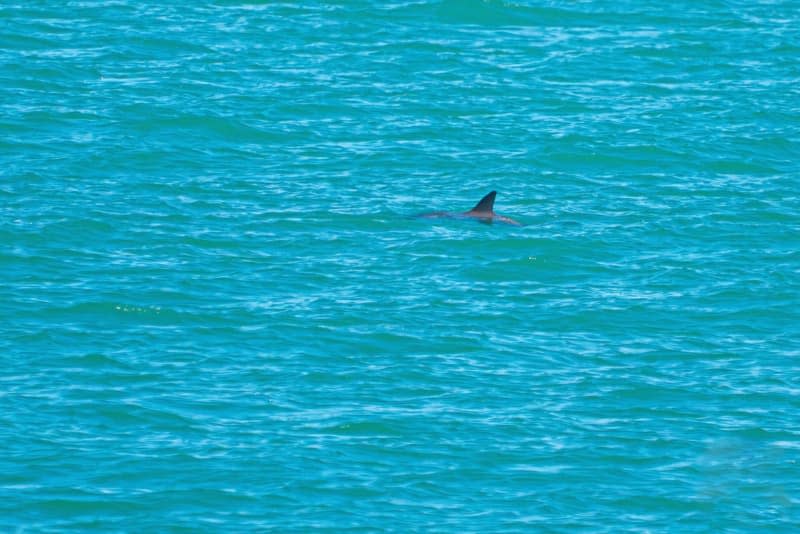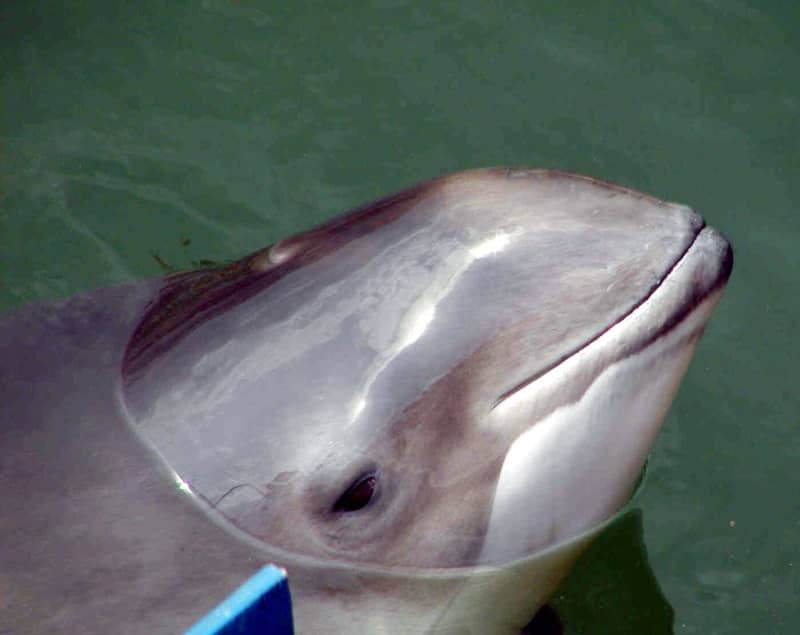The secret sex lives of harbor porpoises in the San Francisco strait

Bill Keener's eyes widened as he peered through his binoculars and spotted the dark, shiny dorsal fins swiftly bobbing along the surface of San Francisco Bay. "There's three of them coming right at us," he said.
It was a drizzly Tuesday morning in winter, and the Marine Mammal Center field researcher and I had been wandering along the pedestrian walkway on the Golden Gate Bridge for about an hour. Cars whooshed past us as we dodged bicyclists and paused at lookout points, keenly peering over the steel railing toward the murky turquoise water about 200 feet below. We were hoping to catch a glimpse of the species he's been closely tracking for decades: the harbor porpoise, a shy yet charismatic creature that nearly disappeared from the bay altogether.
The trio of small cetaceans briefly surfaced once or twice, drawing closer to the eddies that rippled like a shiny ooze over the bay as the porpoises hunted for schooling fish. Clusters of gulls were never too far away, squawking overhead as they waited to make away with a snack of their own.
By the time high tide approached, the harbor porpoises appeared by the dozen, swimming in perfect sync, blowing bubbles and charging through the water at speeds of up to 15 mph. Suddenly, one of the porpoises darted toward another one like a bat out of hell, leaving a frothy white swell in its wake. The interaction didn't last for more than a second.
Keener and I both looked at each other. Did we just see what we thought we did?
As docile and elusive as they may be, it turns out harbor porpoises have a surprisingly active sex life — right underneath San Francisco's most well-known landmark — and we had just witnessed one of the most unique mating rituals in the animal kingdom. Prior to recent studies conducted here by the Marine Mammal Center's cetacean field research program, harbor porpoise mating activity was rarely reported or documented, and the bridge provides the only setting of its kind in the world where the noise-sensitive animals can be observed by biologists without boats or other vessels scaring them off.
"We jokingly refer to it as the 'funnel of love' for porpoises," Keener said of the mile-wide strait, where hundreds of porpoises from as far north as the Russian River down to Pigeon Point in San Mateo County congregate as often as twice a day. "Imagine living in a rural area and you don't have a lot of social contact with your neighbors, but you go to a barn dance on Saturday night, and that's where all the locals are. That's kind of what it is."
A new book published by Springer late last year, "Sex in Cetaceans," reveals groundbreaking findings regarding the species' unusual mating behavior — specifically that it's not exclusive to harbor porpoises in the bay, and is in fact demonstrated by populations all over the globe, from Alaska to the East Coast, Greenland to Japan and down to West Africa. This kind of knowledge is crucial because it not only helps conservationists' work to maintain the species' strong numbers throughout most of their range, but also come up with strategies for subpopulations living in the Baltic Sea and the Black Sea, where they are classified as critically endangered and endangered, respectively, according to the International Union for Conservation of Nature's Red List.
"You have to follow the science where it goes, but the point for us is there is a conservation link here," Keener said.
A disappearance from San Francisco Bay
Harbor porpoise bones uncovered in shell mounds from prehistoric Native American populations around the bay revealed that the animals — which are often mistaken for dolphins but have a distinct family of their own — were commonly found and hunted throughout the region for centuries, Keener explained. But at the onset of World War II in the 1930s, dozens of ships began to crowd the Golden Gate, and underwater nets were cast out to keep enemy submarines away as hundreds of mines dotted the waters beneath the shoals.
All of these factors were exacerbated by an increase of environmental contaminants in the water that likely drove away the porpoises. Keener grew up in San Francisco, and remembers going across the Bay Bridge in the '50s when he was young and taking in the pungent odor that always seemed to emanate from below.
"It would stink like a cesspool because there were no laws preventing industrial discharge and sewage from flowing in," he said. "I had been interested in harbor porpoises for a long time, but I never expected to see them in San Francisco Bay."
More than 60 years would pass from their disappearance until they came back.
The introduction of the Clean Water Act in 1972 helped generate more favorable conditions for harbor porpoises, as well as other marine mammals in the bay, such as whales, sea lions and harbor seals. Experts also theorize that the harbor porpoises lost their institutional memory of the bay as a habitat and new generations had to rediscover it again.
By 2008, one of Keener's late colleagues, Jonathan Stern, a marine ecologist and adjunct professor in San Francisco State University's department of biology, was conducting a study on minke whales when he made the notable discovery that harbor porpoises were reoccupying the bay again on a daily basis after their yearslong absence. As the population boomed, a team of scientists founded Golden Gate Cetacean Research (now the Marine Mammal Center's cetacean field research program) and secured a first-of-its-kind permit from the National Marine Fisheries Service in order to paint a clearer picture of the animals' numbers, survival rates and social lives.
"We got to see things we've never seen before and gain an understanding of these creatures we had never had," Marc Webber, another research biologist for the Marine Mammal Center, said during a recent conversation over Zoom. "They're sneaky little guys and have more interesting behaviors than we ever gave them credit for."
'Life in the fast lane'
Researchers had initially observed the harbor porpoises from Cavallo Point near the Marine Mammal Center's headquarters in Sausalito but quickly learned that with the right timing and the right gear, the Golden Gate Bridge was where they needed to be if they wanted to see some action. In the days before drones, the landmark provided a rare window into the harbor porpoises' day-to-day activity. As researchers spent hours crisscrossing the pedestrian walkway with cameras in hand, adjusting their shutter speed and trading tips on lenses, they documented one new discovery after another.
Harbor porpoises are known to "live life in the fast lane," Webber said, using a term coined by porpoise expert Andrew Read. They mature and bear young early on in life because of their brief life expectancy, which is one of the the shortest out of any cetacean at just 10 to 12 years. They have a high metabolic demand and are constantly on the move, swimming as far as 40 miles in a single day.
Yet, biologists learned that porpoise calves remained close to their mothers for at least a year before venturing off on their own. The animals also engaged in unexpected activities that appeared to be just for fun, such as wake riding off the stern of a large merchant ship. But there was one photo in particular that made all of the researchers do a double take.
It was a male harbor porpoise mid-air, having leapt clear out of the water. At first, they assumed he must have been trying to feed. But upon closer inspection, they noticed something, um, peculiar going on with his anatomy.
"I mean, quite literally for a moment, we thought, 'Is this animal hurt? Is that something coming out of its body?'" Webber said. "It took a moment because it was so unanticipated. We kind of had to zoom in and study the image for a little bit, and lo and behold: This male was in mating mode, and he was out in the air for all to see, you might say."
Up until that photo was taken, harbor porpoises were not known to jump out of the water, or make much of a show of themselves at all. But this one was making a pass by a female in an attempt to copulate with her, and he was doing it so quickly and energetically that the momentum was enough to carry him above the surface of the bay. (The resulting splash can be intensified by the response of the female, which is usually not expecting the surprise encounter and will aggressively throw her flukes at the male.)
Loading...
"The male will fly into the air — he'll actually get airborne — and he misses 99% of the time," Keener said.
Once again, scientists knew nothing about the sex lives of harbor porpoises. What they did know was that most marine mammals, like dolphins and whales, partook in mating activity belly-to-belly. So they did what they had to do: try to take as many photos of harbor porpoises in the act as possible.
But their findings raised more questions than answers.
'These animals are locked into a sexual arms race'
Researchers learned that male harbor porpoises are slightly smaller than female harbor porpoises, which is uncommon in most species because it means the males aren't competing with each other for mates. Instead, they have to use their nimble nature to their advantage, going from female to female and trying to get as much of their own semen into as many harbor porpoises as quickly as possible in order to beat out any other potential suitors.
The resulting ritual is rather short-lived and not very romantic, lasting only about one to two seconds. "Blink and you'll miss it," Webber joked.
But scientists noticed a curious thing: that male harbor porpoises were only approaching the females from the left side, which had never been documented in marine mammals before. At first, they thought it might have something to do with echolocation, but Dara Orbach, a researcher at Texas A&M University-Corpus Christi who specializes in mammalian reproductive behavior and anatomy, took a closer look.
Using silicon molds of reproductive tracts from stranded harbor porpoises, she encountered something truly bizarre within their already complex anatomy, which she described as the "most complicated" out of all 14 sea mammals she had been studying. The muscular spirals of the female's corkscrew-like vagina twisted in the opposite direction of the male's penis and had a series of up to 13 folds, suggesting the possibility that the females had evolved to elude the males, control paternity, and possibly even expel their sperm from their bodies. The harbor porpoise penis, in turn, was shaped like a meaty hook that bent to the left and appeared to be trying to poke through the intricate chambers of the female's reproductive tract to reach her cervix. It would make sense, then, that males would have the best chance of fertilizing females if they approached them from a specific angle.
"That was the answer to the mystery," Keener said. "These animals are locked into a sexual arms race, and what we're seeing here is evolution in action."
Researchers now knew that harbor porpoises were the only species in the world to have sexual asymmetry coupled with this distinctive lateralized behavior. "It's extraordinarily rare to see both both behavior and sexual anatomy co-evolve in this way," Orbach said.
But they started to scratch their heads once again. Were harbor porpoises only doing this in San Francisco Bay, or was it happening everywhere?
A global phenomenon
The team of Bay Area biologists connected with marine mammal experts all over the world, collecting data from eight different countries, including Denmark, Germany, the United Kingdom, Canada and Romania. Together, they determined the unique mating activity was universal across all harbor porpoises, but also observed new behaviors altogether. In one instance in the U.K., researchers found evidence of a male harbor porpoise sexually approaching another male by hooking its penis around the other porpoise's tail stock. And in Denmark, drone footage was captured of a young male calf no more than 10 months old that sexually interacted with its mother by rushing toward her from the left side. Such behavior has been seen before in other species, such as bottlenose dolphins, but poses new questions for researchers like Orbach, who is still working to determine whether these actions are genetically built into the animals or learned by witnessing similar behavior from other individuals in the wild.
"I have a lot of questions about nature versus nurture that I think would be interesting to answer, and we can do so by looking at animals that aren't in the wild," Orbach said, noting that a facility in Denmark that raises captive harbor porpoises has been increasing its observations of mating patterns so they can learn more. "I think that there's been so little research on the sex lives of harbor porpoises in general because it's such a challenging field — they're often submerged beneath the water and not always visible — so it's exciting to me that we're exploring this topic that hasn't been covered for a long time."
The ongoing research is critical, Orbach added, because of the social stigma around discussing concepts of mating in the science world, especially with female genitalia. "This is still anatomy, and we need to be discussing this," she said. "Pointing out deficits in our knowledge and showing alternative ways to answer these questions has been really rewarding and offers potential to future researchers."
Ultimately, Keener and Webber believe that having an acute understanding of harbor porpoises and identifying key components of social hotspots like San Francisco Bay may also help scientists hoping to foster marine conservation areas — and ideal mating conditions — for similar cetaceans they don't know as much about, such as the extremely rare Burmeister's porpoise in South America, and the vaquita, a species native to Baja California that's nearly extinct, with only 10 individuals left. Notably, the vaquita's reproductive anatomy bears "a remarkable resemblance" to that of the harbor porpoise's, Orbach said, and more knowledge about vaquita breeding behavior could save the species.
"What we've learned from San Francisco Bay is literally trying to inform what these other researchers can look out for and see," Keener said.
And while harbor porpoises currently have a healthy population throughout the Bay Area, Keener said it's important to note risks like entanglement from fishing gear, tidal energy generators and electricity from underwater turbines that are currently harming porpoises in the Baltic Sea as similar wind farms could head toward California'sCentral Coast.
"Our coast will be developed too," Keener said. "So understanding why porpoises chose to come back into a very noisy San Francisco Bay — perhaps because there's food and these mating opportunities — proves that if you clean an area and make it habitable for them, they will use it again. They will come back and we've seen that."



